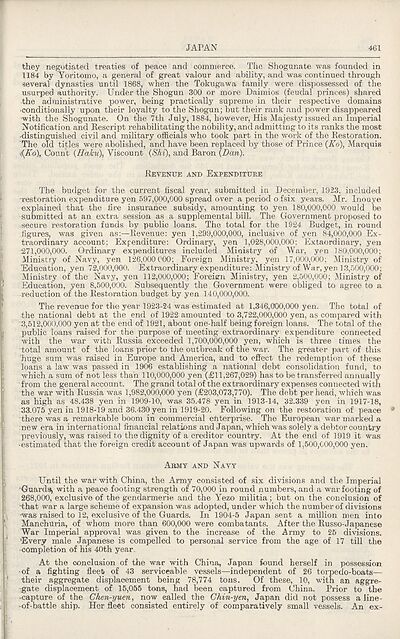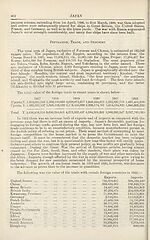1924
(517) Page 461
Download files
Complete book:
Individual page:
Thumbnail gallery: Grid view | List view

JAPAN
461
they negotiated treaties of peace and commerce. The Shogunate was founded in
1184 by Yoritomo, a general of great valour and ability, and was continued through
several dynasties until 1868, when the Tokugawa family were dispossessed of the
usurped authority. Under the Shogun 300 or more Daimios (feudal princes) shared
the administrative power, being practically supreme in their respective domains
■conditionally upon their loyalty to the Shogun; but their rank and power disappeared
-with the Shogunate. On the 7th July, 1884, however, His Majesty issued an Imperial
Notification and Rescript rehabilitating the nobility, and admitting to its ranks the most
'distinguished civil and military officials who took part in the work of the Restoration.
The old titles were abolished, and have been replaced by those of Prince (/To), Marquis
•{Ko\ Count (Haku), Yiscount (Shi), and Baron (Dan).
Revenue and Expendituee
The budget for the current fiscal year, submitted in December, 1923. included
restoration expenditure yen 597,000,000 spread over a period o fsix years. Mr. Inouye
explained that the fire insurance subsidy, amounting to yen 180,000,000 would be
submitted at an extra session as a supplemental bill. The Government proposed to
secure restoration funds by public loans. The total for the 1924 Budget, in round
figures, was given as:—Revenue: yen 1,299,000,000, inclusive of yen 84,000,000 Ex¬
traordinary account; Expenditure: Ordinary, yen 1,028,000,000; Extaordinary, yen
271,000,000. Ordinary expenditures included Ministry of War, yen 180,000,000;
Ministry of Navy, yen 126,000 000; Foreign Ministry, yen 17,000,000; Ministry of
Education, yen 72,000,000. Extraordinary expenditure: Ministry of War, yen 13,500,000;
Ministry of the Navy, yen 112,000,000; Foreign Ministry, yen 2,500,000; Ministry of
Education, yen 8,500,000. Subsequently the Government were obliged to agree to a
reduction of the Restoration budget by yen 140,000,000.
The revenue for the year 1923-24 was estimated at 1,346,000,000 yen. The total of
the national debt at the end of 1922 amounted to 3,722,000,000 yen, as compared with
3,512,000,000 yen at the end of 1921, about One-half being foreign loans. The total of the
public loans raised for the purpose of meeting extraordinary expenditure connected
with the war with Russia exceeded 1,700,000,000 yen, which is three times the
total amount of the loans prior to the outbreak of the war. The greater part of this
huge sum was raised in Europe and America, and to effect the redemption of these
loans a law was passed in 1906 establishing a national debt consolidation fund, to
which a sum of not less than 110,000,000 yen (£11,267,029) has to be transferred annually
from the general account. The grand total of the extraordinary expenses connected with
the war with Russia was 1,982,000,000 yen (£203,073,770). The debt per head, which was
as high as 48.438 yen in 1909-10, was 35.478 yen in 1913-14, 32.339 yen in 1917-18,
33.075 yen in 1918-19 and 36.430 yen in 1919-20. Following on the restoration of peace
there was a remarkable boom in commercial enterprise. The European war marked a
new era in international financial relations and Japan, which was solely a debtor country
previously, was raised to the dignity of a creditor country. At the end of 1919 it was
•estimated that the foreign credit account of Japan was upwards of 1,500,000,000 yen.
Army and Navy
Until the war with China, the Army consisted of six divisions and the Imperial
Uruardsj with a peace footing strength of 70,000 in round numbers, and a war footing of
268,000, exclusive of the gendarmerie and the Yezo militia; but on the conclusion of
"that war a large scheme of expansion was adopted, under which the number of divisions
was raised to 12, exclusive of the Guards. In 1904-5 Japan sent a million men into
Manchuria, of whom more than 600,000 were combatants. After the Russo-Japanese
War Imperial approval was given to the increase of the Army to 25 divisions.
'Every male Japanese is compelled to personal service from the age of 17 till the
•completion of his 40th year.
At the conclusion of the war with China, Japan found herself in possession
of a fighting fleet of 43 serviceable vessels—independent of 26 torpedo-boats—
their aggregate displacement being 78,774 tons. Of these, 10, with an aggre-
■gate displacement of 15,055 tons, had been captured from China. Prior to the
•capture of the Chen-yuen, now called the Chin-yen, Japan did not possess a line-
•of-battle ship. Her fleet consisted entirely of comparatively small vessels. An ex-
461
they negotiated treaties of peace and commerce. The Shogunate was founded in
1184 by Yoritomo, a general of great valour and ability, and was continued through
several dynasties until 1868, when the Tokugawa family were dispossessed of the
usurped authority. Under the Shogun 300 or more Daimios (feudal princes) shared
the administrative power, being practically supreme in their respective domains
■conditionally upon their loyalty to the Shogun; but their rank and power disappeared
-with the Shogunate. On the 7th July, 1884, however, His Majesty issued an Imperial
Notification and Rescript rehabilitating the nobility, and admitting to its ranks the most
'distinguished civil and military officials who took part in the work of the Restoration.
The old titles were abolished, and have been replaced by those of Prince (/To), Marquis
•{Ko\ Count (Haku), Yiscount (Shi), and Baron (Dan).
Revenue and Expendituee
The budget for the current fiscal year, submitted in December, 1923. included
restoration expenditure yen 597,000,000 spread over a period o fsix years. Mr. Inouye
explained that the fire insurance subsidy, amounting to yen 180,000,000 would be
submitted at an extra session as a supplemental bill. The Government proposed to
secure restoration funds by public loans. The total for the 1924 Budget, in round
figures, was given as:—Revenue: yen 1,299,000,000, inclusive of yen 84,000,000 Ex¬
traordinary account; Expenditure: Ordinary, yen 1,028,000,000; Extaordinary, yen
271,000,000. Ordinary expenditures included Ministry of War, yen 180,000,000;
Ministry of Navy, yen 126,000 000; Foreign Ministry, yen 17,000,000; Ministry of
Education, yen 72,000,000. Extraordinary expenditure: Ministry of War, yen 13,500,000;
Ministry of the Navy, yen 112,000,000; Foreign Ministry, yen 2,500,000; Ministry of
Education, yen 8,500,000. Subsequently the Government were obliged to agree to a
reduction of the Restoration budget by yen 140,000,000.
The revenue for the year 1923-24 was estimated at 1,346,000,000 yen. The total of
the national debt at the end of 1922 amounted to 3,722,000,000 yen, as compared with
3,512,000,000 yen at the end of 1921, about One-half being foreign loans. The total of the
public loans raised for the purpose of meeting extraordinary expenditure connected
with the war with Russia exceeded 1,700,000,000 yen, which is three times the
total amount of the loans prior to the outbreak of the war. The greater part of this
huge sum was raised in Europe and America, and to effect the redemption of these
loans a law was passed in 1906 establishing a national debt consolidation fund, to
which a sum of not less than 110,000,000 yen (£11,267,029) has to be transferred annually
from the general account. The grand total of the extraordinary expenses connected with
the war with Russia was 1,982,000,000 yen (£203,073,770). The debt per head, which was
as high as 48.438 yen in 1909-10, was 35.478 yen in 1913-14, 32.339 yen in 1917-18,
33.075 yen in 1918-19 and 36.430 yen in 1919-20. Following on the restoration of peace
there was a remarkable boom in commercial enterprise. The European war marked a
new era in international financial relations and Japan, which was solely a debtor country
previously, was raised to the dignity of a creditor country. At the end of 1919 it was
•estimated that the foreign credit account of Japan was upwards of 1,500,000,000 yen.
Army and Navy
Until the war with China, the Army consisted of six divisions and the Imperial
Uruardsj with a peace footing strength of 70,000 in round numbers, and a war footing of
268,000, exclusive of the gendarmerie and the Yezo militia; but on the conclusion of
"that war a large scheme of expansion was adopted, under which the number of divisions
was raised to 12, exclusive of the Guards. In 1904-5 Japan sent a million men into
Manchuria, of whom more than 600,000 were combatants. After the Russo-Japanese
War Imperial approval was given to the increase of the Army to 25 divisions.
'Every male Japanese is compelled to personal service from the age of 17 till the
•completion of his 40th year.
At the conclusion of the war with China, Japan found herself in possession
of a fighting fleet of 43 serviceable vessels—independent of 26 torpedo-boats—
their aggregate displacement being 78,774 tons. Of these, 10, with an aggre-
■gate displacement of 15,055 tons, had been captured from China. Prior to the
•capture of the Chen-yuen, now called the Chin-yen, Japan did not possess a line-
•of-battle ship. Her fleet consisted entirely of comparatively small vessels. An ex-
Set display mode to:
![]() Universal Viewer |
Universal Viewer | ![]() Mirador |
Large image | Transcription
Mirador |
Large image | Transcription
Images and transcriptions on this page, including medium image downloads, may be used under the Creative Commons Attribution 4.0 International Licence unless otherwise stated. ![]()
| Asian directories and chronicles > 1924 > (517) Page 461 |
|---|
| Permanent URL | https://digital.nls.uk/196430604 |
|---|
| Attribution and copyright: |
|
|---|---|
| Description | Volumes from the Asian 'Directory and Chronicle' series covering 1917-1941, but missing 1919 and 1923. Compiled annually from a multiplicity of local sources and research. They provide listings of each country's active corporations, foreign residents and government agencies of all nationalities for that year, together with their addresses. Content includes: various treaties; coverage of conflicts; currencies and taxes; consular fees; weights and measures; public holidays; festivals and traditions. A source of information for both Western states and communities of foreigners living in Asia. Published by Hongkong Daily Press. |
|---|---|
| Shelfmark | H3.86.1303 |
| Additional NLS resources: |
![[Page 460]Japan](https://deriv.nls.uk/dcn4/1964/3059/196430593.4.jpg)
